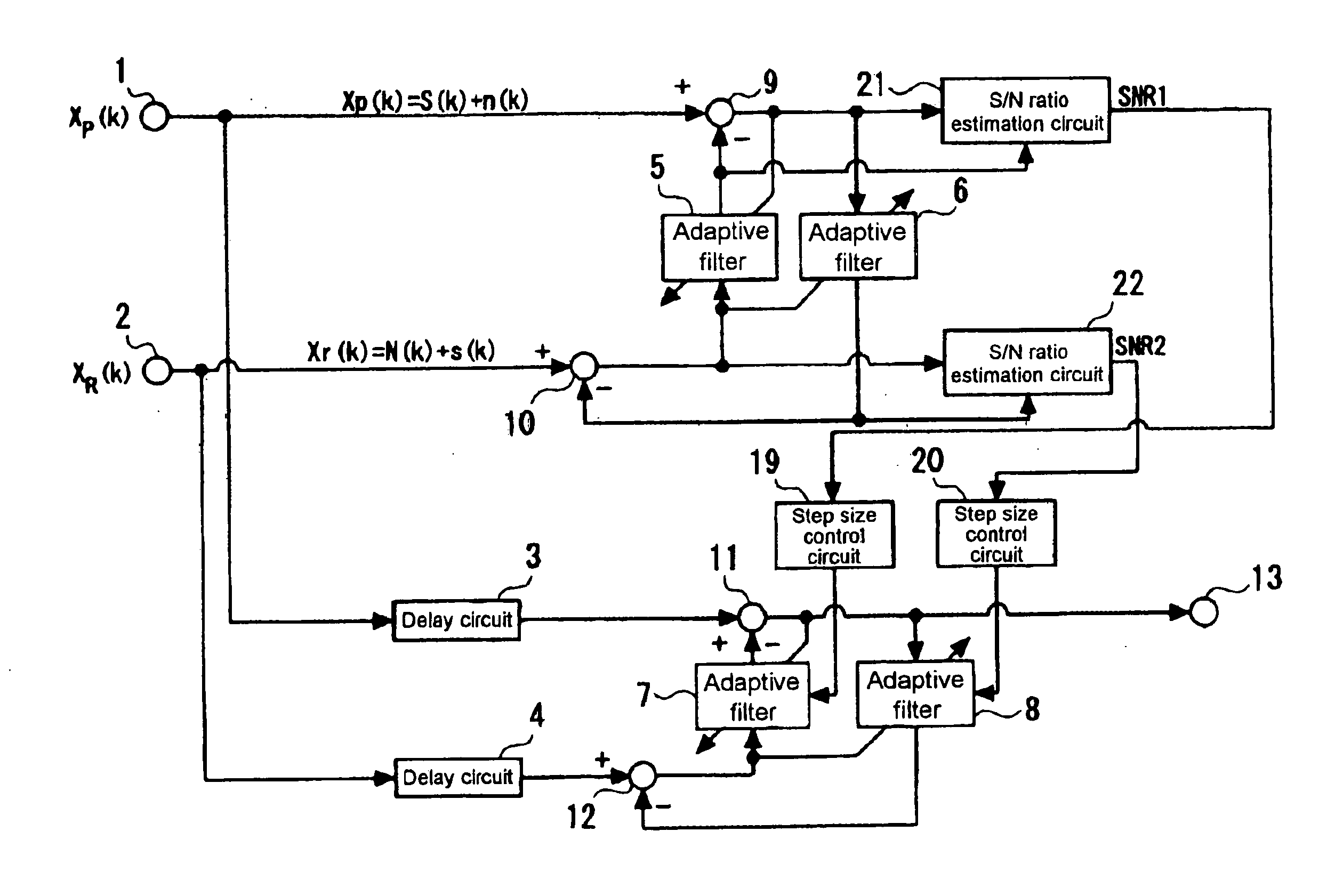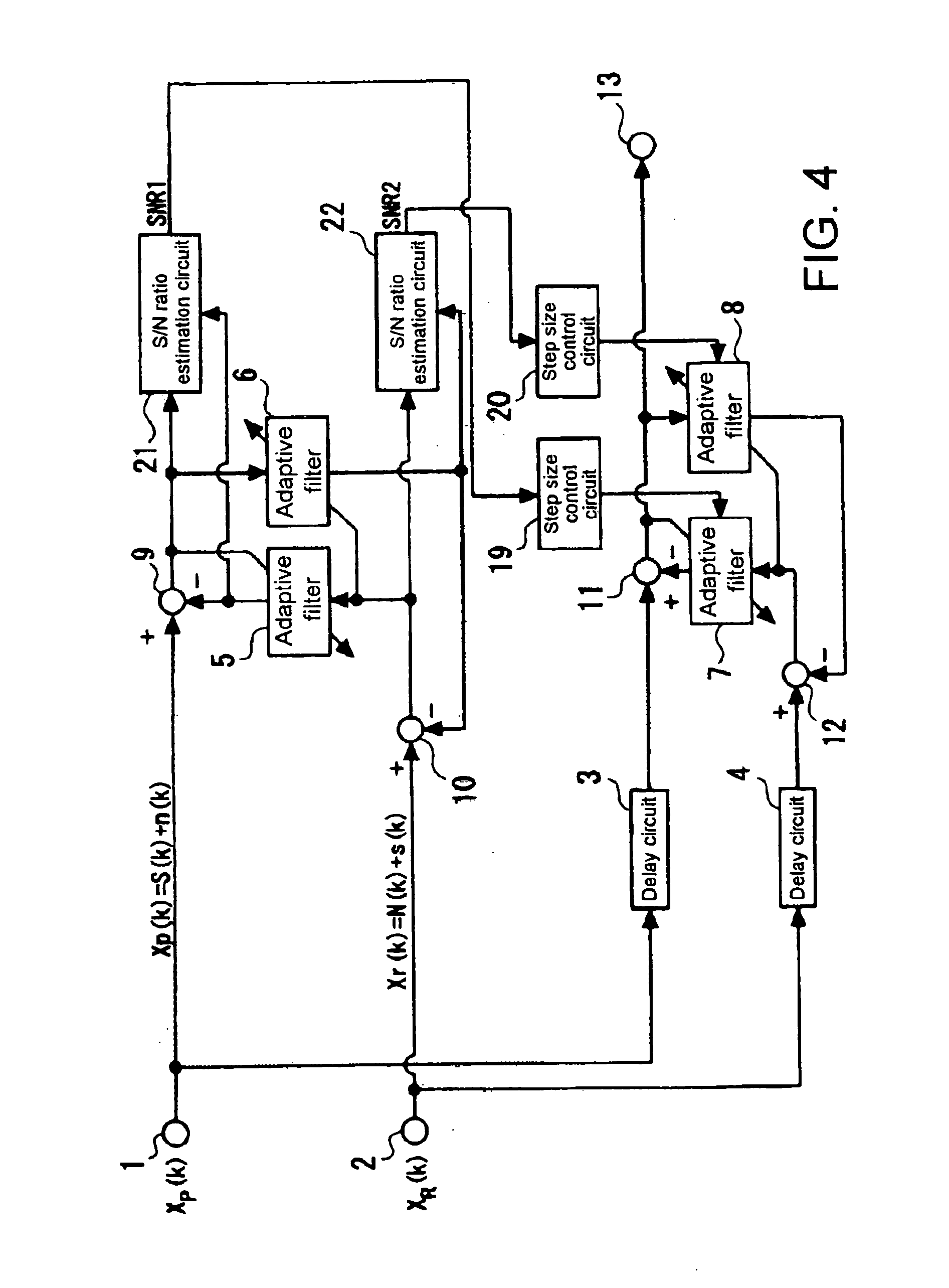Signal processing method and apparatus
- Summary
- Abstract
- Description
- Claims
- Application Information
AI Technical Summary
Benefits of technology
Problems solved by technology
Method used
Image
Examples
first embodiment
[0097] The signal processor of the present invention shown in FIG. 5 is provided with: speech input terminal 1; reference input terminal 2; output terminal 13; first delay circuit 3 for receiving first received sound signal XP(k) which is received from speech input terminal 1 and conferring to the first received sound signal a delay time that has been determined in advance to generate a first delayed received sound signal; second delay circuit 4 for receiving a second received sound signal XR(k) which is received from reference input terminal 2, giving the second received sound signal a delay time that is the same as that of first delay circuit 3 to generate a second delayed received sound signal; first subtractor 11 for subtracting a first pseudo noise signal from the first delayed received sound signal to generate a first error signal; a second subtractor 12 for subtracting the first pseudo speech signal from the second delayed received sound signal to generate a second error sign...
second embodiment
[0135] The signal processor of the second embodiment that is shown in FIG. 6 is provided with: speech input terminal 1; reference input terminal 2; output terminal 13; first delay circuit 3 for receiving first received sound signal XP(k) as input from speech input terminal 1 and giving a predetermined delay time to the first received sound signal to generate a first delayed received sound signal; second delay circuit 4 for receiving second received sound signal XR(k) as input from reference input terminal 2 and giving a delay time that is the same as that of first delay circuit 3 to second received sound signal to generate second delayed received sound signal; first subtractor 11 for subtracting a first pseudo noise signal from the first delayed received sound signal to generate a first error signal; second subtractor 12 for subtracting the first pseudo speech signal from the second delayed received sound signal to generate a second error signal; first adaptive filter 7 for receivin...
third embodiment
[0145] The signal processor of the third embodiment that is shown in FIG. 7 is provided with: speech input terminal 1; reference input terminal 2; output terminal 13; first delay circuit 3 for receiving first received sound signal XP(k) as input from speech input terminal 1 and giving a predetermined delay time to the first received sound signal to generate a first delayed received sound signal; second delay circuit 4 for receiving second received sound signal XR(k) which is received from reference input terminal 2 and giving the second received sound signal the same delay time as first delay circuit 3 to generate a second delayed received sound signal; first subtractor 11 for subtracting a first pseudo noise signal from the first delayed received sound signal to generate a first error signal; second subtractor 12 for subtracting the first pseudo speech signal from the second delayed received sound signal to generate a second error signal; first adaptive filter 7 for receiving the s...
PUM
 Login to View More
Login to View More Abstract
Description
Claims
Application Information
 Login to View More
Login to View More - R&D
- Intellectual Property
- Life Sciences
- Materials
- Tech Scout
- Unparalleled Data Quality
- Higher Quality Content
- 60% Fewer Hallucinations
Browse by: Latest US Patents, China's latest patents, Technical Efficacy Thesaurus, Application Domain, Technology Topic, Popular Technical Reports.
© 2025 PatSnap. All rights reserved.Legal|Privacy policy|Modern Slavery Act Transparency Statement|Sitemap|About US| Contact US: help@patsnap.com



